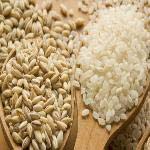
This is the VOA Special English Health Report.
Rice is an important part of many people's diets. Researchers from the Harvard School of Public Health in Massachusetts have released a report about rice. It shows that eating white rice increases the risk of Type Two diabetes. However, eating brown rice reduces the risk of the disease.
The World Health Organization says more than 220 million people worldwide have diabetes. Type Two diabetes results when the body cannot effectively use the sugar it produces.
More than 39,000 men and 157,000 women took park in the study. They were asked about their diet and day-to-day activities, as well as any pre-existing diseases. The study found that the people who ate five or more servings of white rice per week had a 17 percent increased risk of developing Type Two diabetes. But those who ate two or more servings of brown rice a week had an 11 percent reduced risk of getting the disease.
Brown rice is the grain in its natural form. White rice results after it has been refined. This involves removing the outer cover, including the husk, bran and germ. Only the inner white kernel is left. White rice is often enriched to replace some nutrients lost during the refining process.
Qi Sun is the lead writer of the report. He says the outer parts of brown rice slow down the work of the body's digestive enzymes into starch. This means that the release of sugar into the bloodstream is slower after eating brown rice compared to white rice.
A diet of foods that quickly release sugar into the bloodstream has been linked with a greater risk of Type two diabetes. The exact reason for this is not known.
Doctor Sun says less refined grains have more nutritional value than refined grains. He says replacing white rice with whole grains like whole wheat or barley could result in a 36 percent lower chance of developing Type Two diabetes. He says people should replace white rice and other refined carbohydrates with whole grains whenever possible.
However, brown rice does not last as long as white rice because of the oil-rich layer of bran. This makes it less usable in poor communities. The International Rice Research Institute is working to develop kinds of white rice whose starch is released more slowly.
And, that's the VOA Special English Health Report. I'm Steve Ember.
bran: the outer covering of grain which is left when the grain is made into flour 糠;麸皮
kernel: the inner part of a nut or seed, or of the stone/pit of a fruit (果实的)仁,核
enzyme: a substance, usually produced by plants and animals, which helps a chemical change happen or happen more quickly, without being changed itself 酶
starch: a white carbohydrate food substance found in potatoes, flour, rice, etc.; food containing this 淀粉;含淀粉的食物
carbohydrate: a substance such as sugar or starch that consists of carbon,hydrogen and oxygen. Carbohydrates in food provide the body with energy and heat. 碳水化合物
Study finds improved way to treat COPD
Study ties new doctors to jump in hospital deaths in July
Study links bedtime rules to better skills in preschool children
Reusing pacemakers could improve heart care in developing world
(来源:VOA 编辑:陈丹妮)
